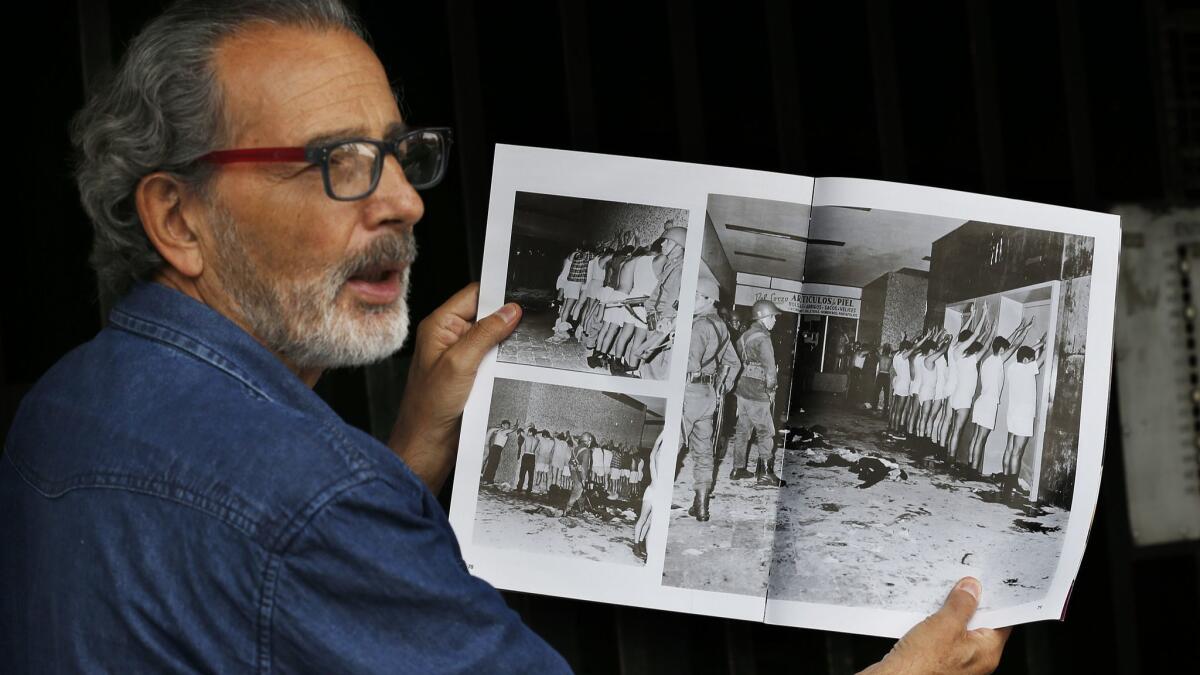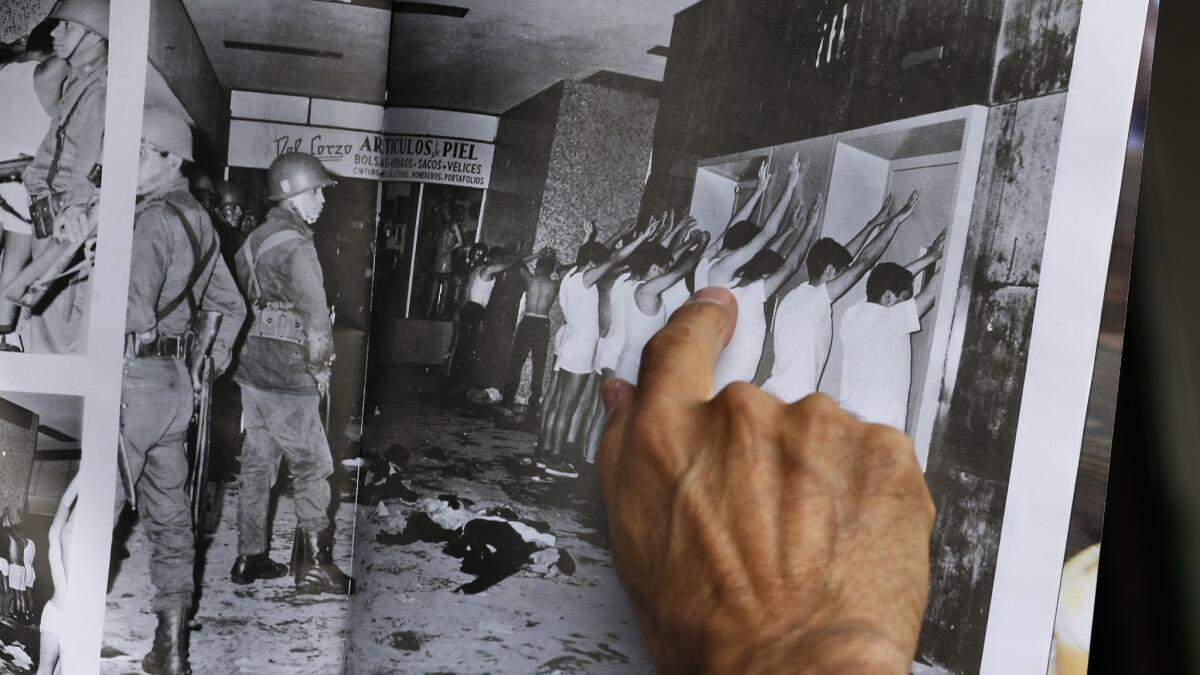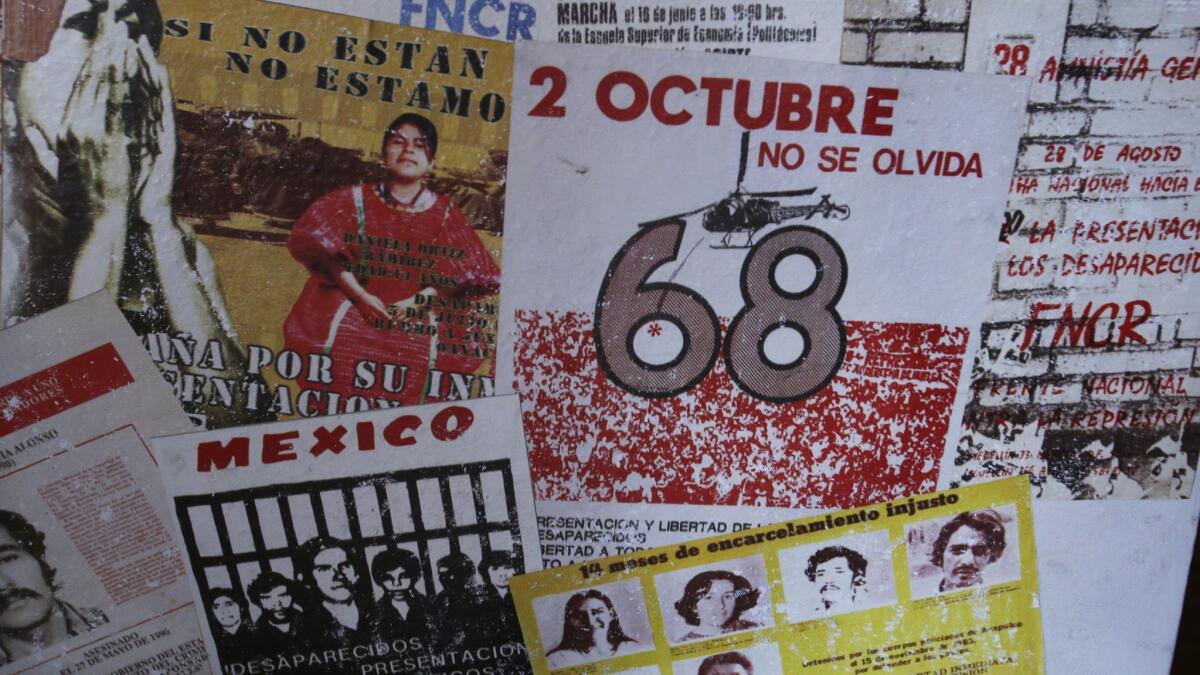As Mexico marks 50th anniversary of Tlatelolco massacre, students say they’re still under attack

- Share via
Reporting from Mexico City — When soldiers massacred at least 44 people — or as many as 300 by some estimates — at a student protest in Mexico City’s Tlatelolco plaza on Oct. 2, 1968, the killers wore uniforms. Today, students in Mexico say they are still under attack, but now from thugs, drug cartels, paramilitaries or rapists.
Today’s student activists — and even the graying veterans of the 1968 democracy movement — acknowledge they now have free speech, something the ’68 generation fought for. But they say the impunity remains the same; nobody was ever convicted for the 1968 killings.
As Mexico marks the 50th anniversary of Tlatelolco on Tuesday, the massacre remains something of an open wound: Nobody knows exactly how many died when soldiers opened fire on a peaceful demonstration. Estimates range from the official version of 25 dead to a more recent investigation that identified 44, but activists at the time claimed large numbers of bodies were carted off in garbage trucks.
It wasn’t until last week that a government agency acknowledged for the first time that it was “a state crime.”
Nor — say both those who survived the attack and the generation that has inherited their activist mantle — has the country learned crucial lessons from the tragedy, with nearly all the crimes of today similarly going unresolved and unpunished, by both state and nonstate actors.
With the exception of a few charred bone fragments, nobody has ever found the bodies of 43 students at a rural teachers college who were kidnapped by police and turned over to a drug gang in September 2014 — another grim anniversary that Mexico marked in recent days with no sign of resolution in sight. The students from the Ayotzinapa teachers college were never seen again.
“We are possibly worse off today. Young people are under attack, with the economy, inequality, there are fewer opportunities,” said Enrique Espinosa, who at 69 remains tall and thin just as he appeared in a famous 1968 photo showing student protesters stripped to their underwear and held at gunpoint by soldiers against a wall in a Tlatelolco apartment building. “This is not the Mexico we wanted.”

Despite the governmental Victims’ Commission’s recent acknowledgement of the massacre as a “state crime that continued beyond Oct. 2 with arbitrary arrests and torture” and a pledge for reparations, justice remains elusive. For example, the government is still fighting a court order that it allow a truth commission to investigate the fate of the 43 students who disappeared in 2014.
“Tlatelolco is a government crime that has remained unpunished, and today the big fight is to break that impunity,” said Felix Hernandez, one of the leaders of the ’68 movement.
Even Hernandez, then an engineering student, acknowledges things have changed for the youths of today. In 1968, “finishing a university degree was a guarantee of getting a secure job. That’s not the case today.”
Times today are different in other ways. In 1968 students struggled against a monolithic government that presided over a booming economy and was at the height of its power. Just a few days after the Tlatelolco massacre, Mexico hosted the Olympic Games.
Related: How 1968, a year of tumultuous events, continues to shape our world »
While the games were marked by dissent — U.S. sprinters Tommie Smith and John Carlos raised their fists in a black power salute — today’s situation is much more chaotic, with a government that is barely in control of many aspects of society, battered by violent drug cartels that are often supported by rogue cops and mayors.
“In 1968 the repression was carried out by the army and riot police; today, it is done through paramilitary groups ... it is a very important difference,” said Victor Guerra, another former leader of the ’68 movement. “Back then, the government was extremely authoritarian, it didn’t allow freedom of expression or demonstrations. Today, thanks to the ’68 movement, we have that possibility, we can protest in the streets.”
Ironically, right before the 50th anniversary, students were back on the street demonstrating after thugs known as porros attacked a student demonstration at the National Autonomous University in September; two students were seriously injured, one knifed in the back. That student’s girlfriend was punched in the face repeatedly as she tried to protect him.
The violence shocked Mexicans who thought porros — ghost students who register but don’t take classes, and instead serve as hired thugs for politicians — were a relic of the past, like the June 10, 1971, march in which porros killed at least a dozen students.
“In 1968, it was more direct repression,” said Mexico City University political science student Josue Gonzalez, 20, as he marched at a protest against the latest attacks. “If the government were to try physical repression today, it would be very stupid, the people would rise up.”
“Now it comes from other groups — from porros — they hire a third party to do their dirty work,” Gonzalez said.
Indeed, some argue that crimes like the disappearance of the 43 students in Iguala 2014, officially blamed on cops in the pay of a drug gang, were actually the work of the government; the students had been a thorn in the side of authorities, and the mayor of the town where they disappeared has been implicated in the crime.
“It is the authorities themselves who attack you,” said Itzel Espinosa, 23, a design major and daughter of Enrique Espinosa of the ’68 movement. “What happened to the 43 is the Oct. 2 of today.”

But today, the brutality is of a different kind. In March, three university film students in the western city of Guadalajara were picked up by a drug gang who mistook them for members of a rival cartel; they were tortured, interrogated and killed, and their bodies dissolved in acid.
“The film students in Guadalajara were out doing a school project. It is unbelievable,” said the younger Espinosa. “That was the drug gangs, but if the government was functional, that kind of crime wouldn’t happen.”
Every student has his or her own tale: “It is the porros, the killings of women ... the kidnappings, the robberies,” said Juan Guijosa, a National University economics student who graduated a few weeks ago.
“Nowadays there is a big problem with crime,” agreed Jorge Chavez Cardenas, another student who was at the September protest. “Right outside our university there have been killings, kidnappings, massacres.”
Among the crimes on campus was the 2017 killing of Lesvy Berlin at the National Autonomous University, which was initially called a suicide but later recognized as a femicide by authorities, sparking multiple protests.
But some things have improved. In 1968 students struggled to distribute leaflets and fought the indifference or lies of government-aligned media; the day after the 1968 massacre, newspapers depicted it as an attack on soldiers, with headlines like “Terrorists and soldiers fought a tough battle” and “Criminal provocation causes bloody confrontation.”
In the digital age, students have the power to communicate with the world at their fingertips.
“The big difference today is social media,” Itzel Espinosa said. “Young people today, we can say what really happened, we have ways to prove it. Back then they didn’t have cellphones, you had no way to prove what happened. You didn’t have a camera in your hand.”
Ensayo: A 50 años de la masacre de Tlatelolco: ¡No, no se olvida! »
More to Read
Sign up for Essential California
The most important California stories and recommendations in your inbox every morning.
You may occasionally receive promotional content from the Los Angeles Times.










